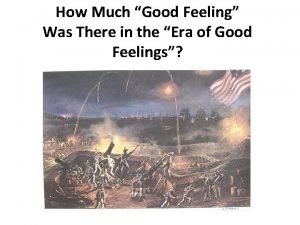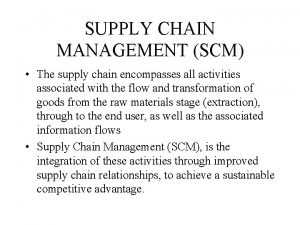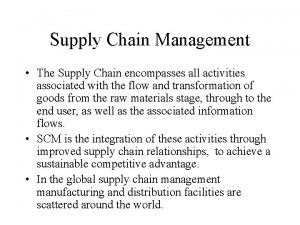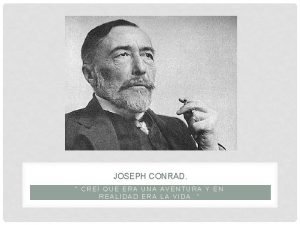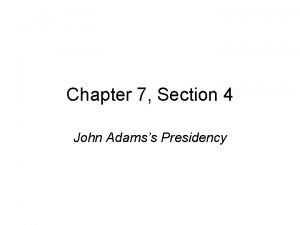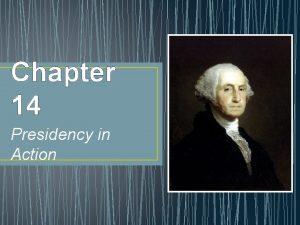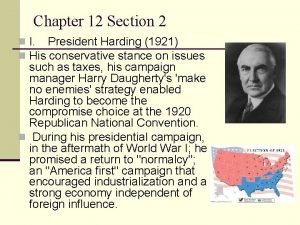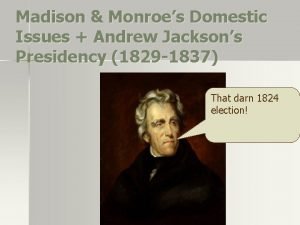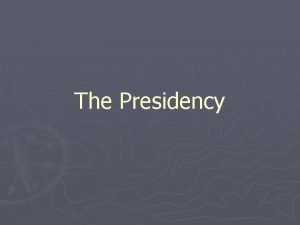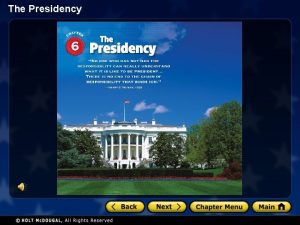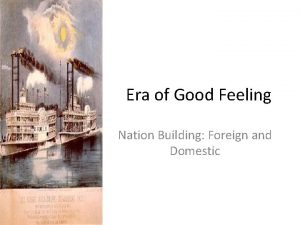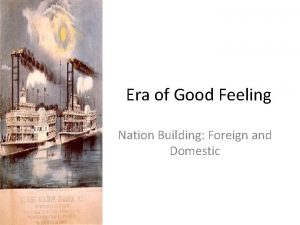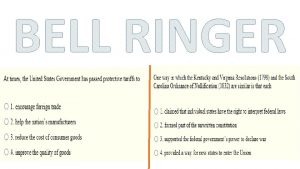The Era of Good Feeling Encompasses Monroes Presidency

























- Slides: 25

The Era of Good Feeling Encompasses Monroe’s Presidency. Only one party at the time, Democratic. Republicans, so the fighting was between factions.

• Jeffersonian Dem-Reps had moved toward some Federalist ideas. • Under Monroe, Henry Clay (Speaker of House) pushes “American System” through Congress • -Second Bank of the United States • -expand military • -internal transportation improvements • -protective tariff • Idea: to end sectional divisions by uniting the country • Boost manufacturing/industry (benefits NE), creating more need for raw materials from the South and West. • Economy doing nicely as a lingering after-affect of War of 1812, until 1819

Panic of 1819 • delayed reaction to end of war in Europe. • British shipping picks back up, hurting U. S. shipping. • European agriculture picks back up after the wars, decreasing demand for U. S. agricultural goods, hurting U. S. farmers. • Credit problems and land speculation: land speculators buying up land in south and west, often on credit, hoping to sell it for more than they bought it for. Not interested in cultivating the land themselves. • Second Bank of U. S. reduced loans (to other, state banks), which meant the state and local banks had less money to loan out, so they had to start demanding payment on loans, and foreclosing on people who couldn’t pay. • This ruined many small farmers and land speculators.

• • • Decline in cotton prices, blamed on tariff. Farmers and speculators pushed the gov’t for help. Relief Act of 1821 -longer time to pay delinquent loans. State relief efforts too, but many small banks still failed. Farmers in South and West blamed the 2 nd bank of U. S. , which they believed only helped Northern manufacturing. Urban workers hit by the panic too. Demanded aid from govt as well, when they didn’t get it, started running their own candidates for office. Believed British imports were hurting them, demanded and got a protective tariff (1824) Panic lasted about 6 years, many dissatisfied people, will play a part in the next presidential election.

The Missouri Compromise • 1819 -Missouri Territory petitioned to be admitted as a state. • Issue of slavery in Missouri. • Invention of the cotton gin made cotton plantation agriculture VERY lucrative, lands in the Louisiana Territory great for cotton. • Southerners want slavery to be able to spread there. • Many northerners opposed slavery, as a moral issue. • Two other issues as well.

The Missouri Compromise • Balance: if Missouri came in as a slave state, then there would be more slave states than “free” states, tipping the balance in Congress. • Powers of regulation: does Congress have the power to regulate slavery in the Western territories? • Southerners see it as a matter to be decided by individual states, and as a property issue, and property is protected in the Constitution.

The Compromise, brokered by Henry Clay Missouri came in as a slave state, Maine split off from Massachusetts and was admitted as a free state, preserving the balance of slave and free states. Line through the Louisiana territory at the 36 degree 30’ parallel. North of the line, slavery was illegal, south of the line, slavery was legal.

The Missouri Compromise • Congress accepted the North’s argument that slavery in the territories was a federal issue, not a state issue. • This Compromise puts off further controversy over slavery for about another 25 years, but didn’t really solve the problems that will eventually lead to the Civil War.

Spanish Florida • 1810 -Spain was defeated by France, and the U. S. used the opportunity to seize West Florida from Spain. • Sec. Of State John Quincy Adams pushed Monroe to take all of Florida. • U. S. offers to buy Florida. • Spain refuses, doesn’t recognize the Louisiana Purchase.

Spanish Florida • Problems w/Florida. • Raids in the South, especially Georgia, by escaped slaves, white outlaws and Native Americans residing in Florida. • Andrew Jackson, assigned to patrol the border, finally given permission to follow attackers into Florida, but strictly forbidden from attacking Spanish towns or Forts. • Disobeyed, attacked Fort St. Marks, captured Pensacola and deposed the Spanish governor.

Spanish Florida • U. S. reaction: general public pleased, Monroe furious, wanted to try Jackson for insubordination. • Quincy Adams sees an opportunity and talks Monroe into going along. • Turns it around on Spain, says Spain isn’t taking care of its colonies, which is why the attacks are occurring and that the U. S. is having to do Spain’s job for them, claims Spanish lands on the border of the LA territory actually belong to the U. S. • Spain, worried about keeping Texas, agrees to negotiate.

Adams-Onis Treaty, Feb. 1819 • set boundary line b/t U. S. and Spain all the way to the Pacific Ocean. • U. S. gave up claims that Texas was part of the LA purchase. • U. S. gets Florida, pays Spain $5 million for damages against Spain by U. S. citizens in Georgia.

The Road to the Monroe Doctrine • Series of decisions/agreements that improved relations between U. S. and Britain. • Britain abandoned Native American allies and stopped trying to stop American expansion past the Rocky Mts. • Treaty to limit naval forces on the Great Lakes • Agreed to the 49 th parallel as the border between the U. S. and British Canada, from the Great Lakes to the Rocky Mts. Agreed to share control of Oregon territory. • England granted the U. S. “most favored nation” status, opening free trade w/Caribbean colonies.


The Road to the Monroe Doctrine • British proposition: • Joint proclamation by U. S. and Britain • Warn other European powers that they had to respect the independence of former colonies, couldn’t try to re-colonize former North or South American colonies. • Out of good nature?

• During Napoleonic Wars, Spanish colonies in Latin America had taken advantage of Spain’s distraction to break free and declare independence. • Spain was too weak to re-colonize, but other nations were strong enough to try. • U. S. and Britain making LOTS of money off trade w/these new independent nations.

Road to the Monroe Doctrine • Monroe was for the deal, but Quincy Adams intervened. • Didn’t want to limit U. S. ’s ability to expand encompass new territories • Factions with in the U. S. who wanted to annex: Texas, Mexico, Cuba, Canada, Caribbean • Joint statement w/Britain might not be received well after just being at war with them. • Wanted Monroe to issue statement w/out British support.

The Monroe Doctrine 1. U. S. won’t get involved in European political affairs 2. U. S. won’t interfere with already established colonies, but would allow no new colonization in the Western Hemisphere. Would view intervention by European nations as a hostile action. • Realistically enforced by Britain, but very economically beneficial to U. S. • Creates concept that Western Hemisphere is the U. S. ’s sphere of influence

Movement toward more democratic government in U. S. • voters becoming more independent. • states eliminating property and religious requirements for voting • elimination of “stand up voting” • written ballots • reapportionment of legislatures • voters choose presidential electors • many appointed offices became elected • Broadened democracy, more people voting, more common people have voice in gov’t

Election of 1824 • Five candidates ran, one party, so all Democrats (the party dropped Republican) • Andrew Jackson • John Quincy Adams • William Crawford • Henry Clay • John C. Calhoun

Election of 1824 • Jackson and Quincy Adams had the most national support. • Others had regional support in their home areas. • Calhoun dropped out of the race before election day. • Voting often based on popularity, personal appeal, since all from same party. • This favored Jackson, since he had appeal as a “war hero” and a “common man”


Election of 1824 • Neither Adams or Jackson won a majority of the electoral votes. • Jackson got the most popular and electoral votes, but not a majority. • 12 th Amendment: no majority, has to be decided by the House. One state=one vote, for one of the top three electoral vote-getters. • Adams won with 13 of 24 delegations voting for him. • Jackson and his supporters were furious, cause they believed that since Jackson won the most popular votes (though not a majority) the House should have voted for him (153, 544 to 108, 740), and they denounced the election.

• Problem got worse when Quincy Adams made Henry Clay his Secretary of State. • Jackson’s supporters claimed Quincy Adams had made a deal w/Clay (who was Speaker of the House during the controversy) to give him the Sec. Of State job, in return for Clay using his position as Speaker to make sure Adams won. • Jackson’s supporters called it “The Corrupt Bargain” • Jacksonian Democrats spent ALL of Adams administration thwarting everything Adams tried to do. • Couldn’t get anything through Congress, even things the Jacksonian Dems didn’t necessarily object to.

Chief Justice Marshall & the Supreme Court • Mc. Culloch v. Maryland: federal law supreme over state law • Congress had the authority to charter a national bank, under implied powers, in the “necessary and proper clause” • Congress can legally exercise power to enhance the nation’s welfare, enact taxes and coin money. • Federal courts supreme over state courts. State court decisions subject to review by federal courts, esp. if concerning federal law. • Reaffirming Federalist agenda: strong central gov’t, loose interpretation of constitution.
 Looking good feeling good
Looking good feeling good War good good feeling
War good good feeling Buenas tardes good afternoon
Buenas tardes good afternoon Hey hi good morning
Hey hi good morning Buenas tardes good afternoon
Buenas tardes good afternoon If you are
If you are Good words good thoughts good deeds
Good words good thoughts good deeds Good feeling power
Good feeling power Cognitive provides various channels for self-realization.
Cognitive provides various channels for self-realization. What encompasses all activities associated with the flow
What encompasses all activities associated with the flow What encompasses all activities associated with the flow
What encompasses all activities associated with the flow The biosphere encompasses all of the
The biosphere encompasses all of the Dfld radar
Dfld radar Chemistry of shampoo
Chemistry of shampoo Crime scene vocabulary
Crime scene vocabulary English cuisine encompasses
English cuisine encompasses Verbal advertisement
Verbal advertisement It encompasses several different aspects including
It encompasses several different aspects including Baroque music quiz
Baroque music quiz Elizabethan vs victorian
Elizabethan vs victorian Creí que era una aventura y en realidad era la vida
Creí que era una aventura y en realidad era la vida Era uma estrela tão alta era uma estrela tão fria
Era uma estrela tão alta era uma estrela tão fria Section 4 the presidency of john adams
Section 4 the presidency of john adams Chapter 14 the presidency in action answer key
Chapter 14 the presidency in action answer key Which trend characterized thomas jefferson's presidency?
Which trend characterized thomas jefferson's presidency? Ch 12 section 2 the harding presidency
Ch 12 section 2 the harding presidency

